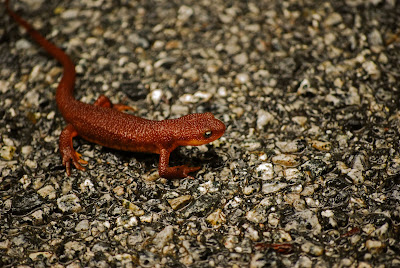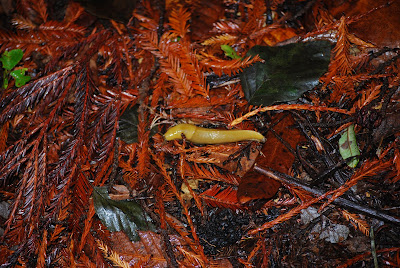 I am seeing wintry oranges everywhere.
I am seeing wintry oranges everywhere. A banana slug slimes across redwood leaf litter on the forest floor.
A banana slug slimes across redwood leaf litter on the forest floor.The dogwood trees turn red, yellow and orange. When the leaves blow off, the deep red stems are featured.

A California towhee shows off its orange tush while eating a hanging persimmon.
 A trio of American robins. Their breasts don't glow as bright as the persimmons, but once you notice their white eye ring, it stands out like the sought-after pattern on a puzzle piece.
A trio of American robins. Their breasts don't glow as bright as the persimmons, but once you notice their white eye ring, it stands out like the sought-after pattern on a puzzle piece.Flocks of modestly colored cedar waxwings can be spotted against the winter sky by the narrow, bright yellow band at the tip of their tails. Perching, you notice their small crest, pale yellow belly, and maybe a red or orangish tip to their secondary feathers caused by their fruit-heavy diet (sometimes described as waxy drops or modifications of the feather shaft which may influence their breeding choices).
Other birds that are feeding on the persimmons are ravens, stellar jays and yellow-rumped warblers, starlings, red-breasted sapsucker, downy woodpecker . While birding in bed the other morning, I saw a red-shafted flicker reach for a dripping glob of persimmon jelly, and incidentally show off his red mustache, orangish eye shadow and the apricot-red of the underside of his tail feathers.
A brown and orange coast range newt crosses a road under stormy skies.
 Some newts don't make it across the road.
Some newts don't make it across the road.
Newts move slowly. They follow the same pathways to water each winter for breeding. When the second big storm of the year arrives, look sharp and notice where the newts cross the country roads. On those sections, slow down enough to check the road surface and straddle the newts with your car wheels.
Orange in the summer is too bright. Orange in the winter is warm and cheerful in a content sorta way. A base of life turning over. Some people have a hard time with the short days in winter - SAD, seasonal affective disorder. Their brains produce more of the hormone melatonin during the longer hours of darkness, and depression, anxiety, hopelessness and oversleeping may set in. Sitting under a certain type of light, phototherapy, might help.
I do okay with the short days if I get up early and am outside or near a window to see the winter sun rise, or if I get a gulp of moonlit night air. I witness the seasonal patterns in my skin and lungs and have winter orange hope and anticipation for longer days.
Happy winter solstice. Peace to you as the days get longer. Bite into a persimmon or bright tangerine for vitamins and to spark up your spirit.






nice orange vision and observations!
ReplyDeleteBeautiful as always!
ReplyDeleteThese entries and their photos would make a great book, ya know.